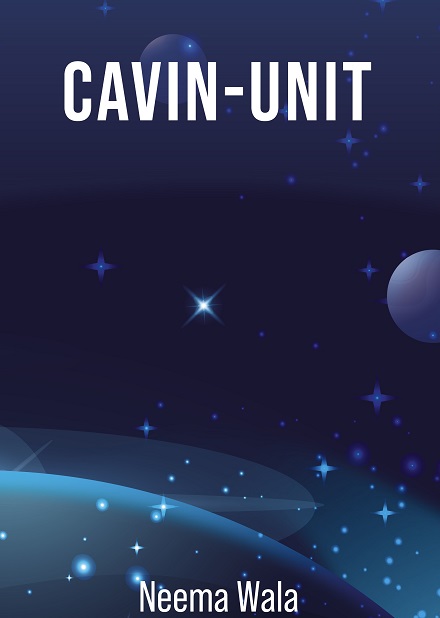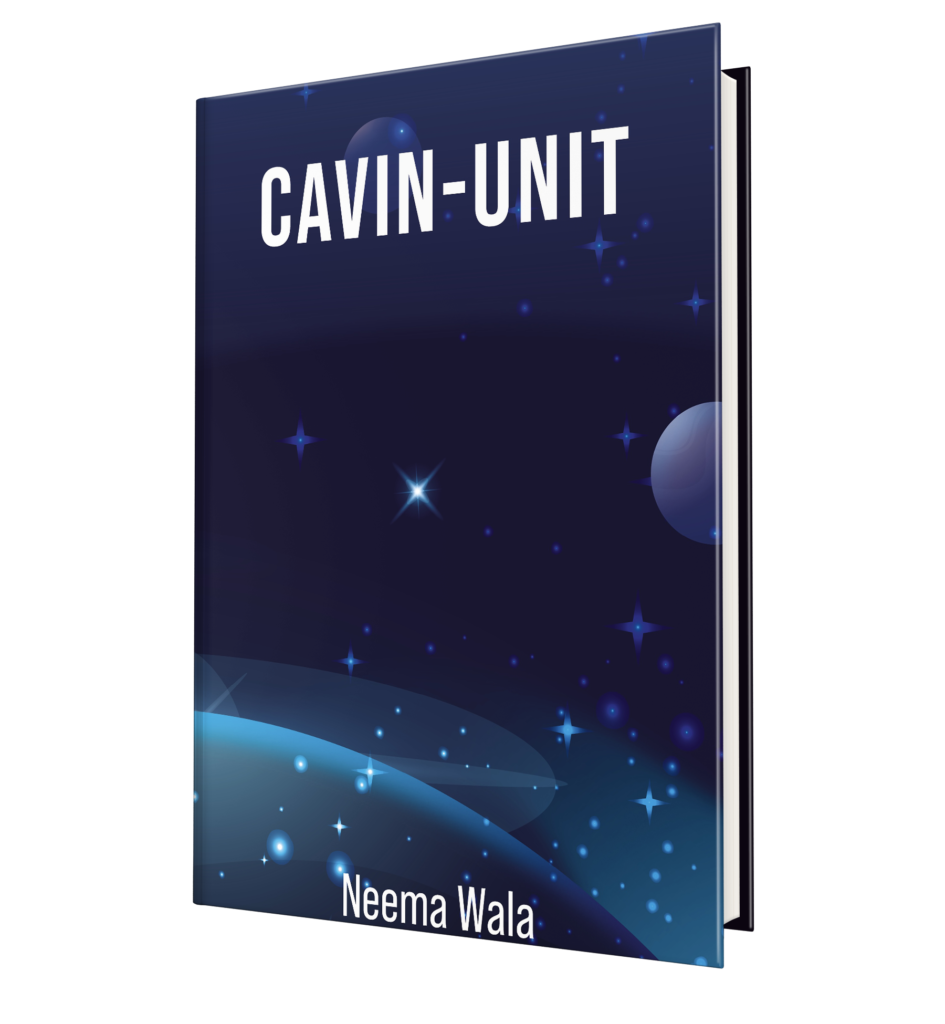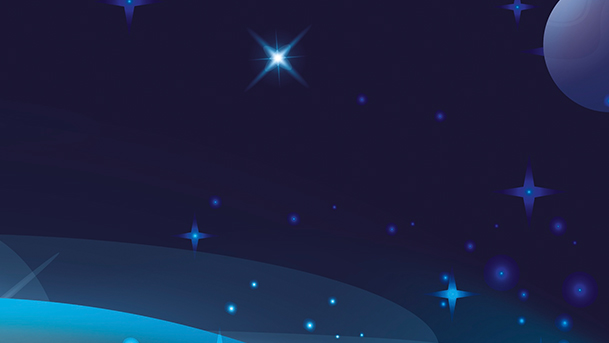Welcome travelers. We recently promoted the debut work of Neema Wala. Cavin-Unit is a science fiction story with a lot of heart, a sense of self-realization, and a journey that shines a different kind of lens on the coming-of-age adventure. Today, we dive a little bit deeper, learning more about how the book came to pass, and discovering just what makes Wala tick. Read on to learn more about this talented author!
Tellest: Greetings, Neema! I wanted to thank you for sparing some of your time to talk to me about your book, your journey, and your process. I know that you worked very hard on your debut, and that you’re likely already deeply engaged in writing whatever comes next, so to be able to steal away even a bit of your time feels like a great privilege. I’m looking forward to opening the door a little further in order to help introduce you to new readers and fans!
Neema Wala: Thank you! It means a lot to hear that.
T: I always like to begin an interview by trying to get a grasp of what informed the author’s love of writing. I enjoy learning about what sort of inspirations led to new stories being written, and new worlds being built. Did you have a favorite author who motivated you to take up the craft? Or did you perhaps have someone in your family or local community who had the spark of creation, and they helped to pass that along to you?
NW: My love for books has always been around since I’ve learned to read. I remember being five, and making my own unlicensed Winnie the Pooh picture books by stapling pages of computer paper together and drawing the illustrations. Tastes and preferences for the types of books I read changed during the earlier years of my life.
But at age nine, that’s when it became more. I started to read the Series of Unfortunate Events books and fell in love with them. It might have been the illustrations, the zaniness of the characters, the vocabulary I’d learn, or the fact that it was the first book series where I got through all the books. All I can say is my passion for reading increased and that my dream of becoming an author sprung because of those books. And it was where I learned to use the word ‘cakesniffer’ as an insult.
T: When you decided that you wanted to be an author, how did your friends and family react? Did they believe in you from the start, or was there perhaps some cynicism or concern?
NW: Fortunately, they were supportive, since they knew this had always been a big dream of mine. I’d get warned about stuff like how saturated the market is, which is an understandable concern, but they’ve been okay with it.
T: You mentioned the saturated market, and how that presents concerns for a new author. Are you of the mind that the aforementioned saturation of available books makes it so that storytellers must compete for a spot on a consumer’s bookshelf—virtual or otherwise—or is it more a challenge of just being able to be seen amidst the huge volume of stories that release?
NW: I believe being able to be seen amongst all other books released is the real challenge. Although I’d be lying if I said that I didn’t feel the urge to compete, writing is very solitary work and most people that aren’t writers usually don’t get what that’s like. Despite what lists or awards are out there for best-selling, best-written book, best new book etc, we all want readers to enjoy our work and we want to be able to make a living from it.
T: On the subject of inspiration, what do you think was the reason that you were inspired to write your first book? What was it about the sci-fi genre that spoke to you?
NW: I had originally intended for my book to be a graphic novel or webcomic that would hopefully get an animated adaptation. I drew some of the characters, but when it came to drawing the comic, I literally gave up on the first panel after because of how difficult it was to make sure everything in each stayed neat, proportionate, and detailed.
I wasn’t sure what I would do with Cavin-Unit, but I always kept the idea in the back of my mind just in case it was unique enough of an idea. When the pandemic hit, people were saying how this was a great opportunity to write a book and I thought about my childhood dream of becoming an author and when I thought about what to write, Cavin-Unit popped up and the rest is history.
As for what drew me to the sci-fi genre, the influence definitely comes more from movies and TV rather than from books. I liked Jimmy Neutron a lot as a kid and thought it was really cool how he invented all kinds of things like a cube that sucked in objects which took the stress out of packing and carrying things, and a hypnotizing ray that could be used on others to make them do things for you, and I’d think about concocting stuff like that to make my life easier. And like most kids, I had a fascination with all things related to outer space and aliens.
Tellest: When you’re developing a sci-fi universe, are you trying to adhere to any rules or to understand the technology implicitly, or do you think it’s more important to tell an entertaining story with flexible guidelines?
NW: I think it’s more important to tell an entertaining story with flexible guidelines. The reader will be aware that the technology in the story will be different or more advanced. But at same time, I believe there should at least be a brief explanation of what the technology does instead of getting too detailed about the mechanics of the technology and boring the reader.

T: Of course, it’s always fun to play with new technology in a story such as Cavin-Unit. But you also have to balance things out with a human element that drives the story forward and keeps the reader’s interest. How would you say you keep your characters interesting and captivating, and make fans eager to follow along on their adventures?
NW: I stick with tropes that I really like. For the characters, for the settings, and I give my characters the interests I have. I’ll think about books/movies/TV shows and the stuff that shocked me or made me laugh.
I’ll also make playlists for my characters and listen to some of the songs from them. I’ve found that it helps depict the character and their motivations and internal conflict a lot better.
T: Your book, Cavin-Unit, is a story that follows a pair of unlikely companions, in ways that most readers might not be expecting. You were able to strike a nice balance between heartfelt and kooky, which is not always easy. How would you say you were able to achieve that?
NW: Since I’d originally intended it to be a comic, I think that helped me with maintaining that balance. I also knew how I wanted the dynamic between Casseia and Nisha to be. Nisha is this naive impressionable kid and Casseia this conniving mad scientist. I’ve always been a fan of this trope, but I’d never seen it amongst two female characters.
While working on Cavin-Unit, I watched Inside Job and BoJack Horseman. Both are animated shows, and because they’re animated, you’d expect them to keep you laughing constantly. They’d have their funny moments, but my jaw would drop during the serious moments. Not just because they were serious per se, but because of the level of seriousness depicted that you wouldn’t expect in cartoons about talking horses or about conspiracy theories. I thought it would be interesting to incorporate storytelling into book format, especially since we live in a time where it’s easier to binge-watch and doom-scroll than it is to get through a book.
Tellest: Do you think that, considering its current state, you could still make Cavin-Unit into a graphic novel, or something along those lines? And if so, would you even want to? Or are you happy with how things have ended up, without any doubt in your world that things transpired the way they were supposed to?
NW: I’m totally open to a graphic novel adaptation of Cavin-Unit! There are plenty of novels out there that have had graphic novel adaptations, and it would be interesting to see the world I had in mind displayed visually.
T: Historically, you’ve done some of the drawings for your work. Going forward, would you try to keep to that, or would you look to loop in new members of your team?
NW: I’ll loop in new members. I don’t have the patience to sit down and draw.
T: While all coming of age stories have their own challenges, it’s got to be exceptionally difficult to write one that also exists within a sci-fi genre, where the protagonist is caught off their guard by how alien and strange everything feels. Were you nervous writing Cavin-Unit, knowing that you would meet those challenges head-on?
NW: Not so much, since there are already a lot of narratives of teenagers living double lives. I connected with those stories as a child of immigrants and familiarizing with two different cultures and having to act differently according to the standards of each culture. But those stories of double lives usually center around white protagonists. And because there are so few characters like Nisha in fiction, I did worry about her being compared to other fictional South Asian girls. And while the book doesn’t really focus a lot on her culture, making sure that it wasn’t portrayed in a negative light was important to me because the last thing I wanted for her was to be self-hating. It’s normal to feel frustrated and insecure at that age, but I wasn’t going to constantly dwell on that. It would go against why I wrote this book, and I didn’t want to convey that to any girls like Nisha who read this book.
Tellest: How do you navigate telling a story that does involve some of the more difficult times in a young person’s life? When we’re growing up and trying to find our identity, there often is a sense of self-loathing, at least for a short while. How do you do that justice while still balancing enough self-love to keep things realistic enough without sabotaging a more positive message?
NW: When the pandemic hit, I was really frustrated about not meeting expectations that I was supposed to meet during adolescence and adulthood. I remember how excited I was to become a teenager when I watched Disney Channel or Nickelodeon only for me to not experience any of the fun, cool stuff that they promised me, and to have to do what other adults told me to do who had little-to-no regard about the things I had to say. As an adult, it was being unhappy with my career and salary, feeling as though I wasted my time and money going to college, and seeing my peers get into relationships and travel the world while I was still single. Casseia and Nisha are meant to represent those stages in my life. Over the past few years, I’ve gotten better at making peace with the choices I’ve made and that’s helped to make the story what it is.
T: In a way, it sounds like Cavin-Unit was a therapeutic writing experience for you. Now, on the other end, it can almost be a helpful story for other people who were once in your seat. Did you anticipate that some of your readers might dive into your book and be seen, perhaps understanding that they were feeling the same things you might have?
NW: I knew I wanted Cavin-Unit to be something that teenage girls and women could resonate with when they read it. Mentioning things like workplace sexism and the treatment you get for mentioning that you’re female on the Internet, which are things that women still have to deal with in 2023. Aside from Casseia and Nisha being female characters you don’t see in sci-fi, they both experience growth as people. Whoever reads the book might feel reassured that they don’t have to worry about not reaching certain milestones at whatever age they are.
T: On the subject of challenges, what did you find to be one of the more difficult things when working on your book? Were their problems during the writing process, or afterward when you were editing, or has the real trouble been things like marketing?
NW: I was faced with all sorts of challenges while working on this book, as is expected for any first-time author. But of the challenges that frustrated me the most would have been sending the first iteration of my manuscript to my editor. She suggested that the word count be longer, and to add more nuance to the story.
I looked back through that first manuscript, and more ideas and changes to make the story better came. I knew it could be better, but the thought of sitting down and starting all over again was daunting to me. But as I incorporated those changes and liked how the story was going, it became less daunting.
Making sure that each chapter alternated between Nisha and Casseia’s POV was challenging, too. Sometimes, one of them would get another chapter afterwards and I would have to read through that chapter, and change the names, dialogue, and their thoughts to maintain that consistency.
Tellest: If things had gone a different way, and you were advised to start over a third time, how do you think your book would evolve in the next iteration you would work on?
NW: There would probably be more of Squiffy featured. I would also have them do more than just talk.

T: Since Cavin-Unit was your first released book, readers will likely be looking for you a bit more to see what comes next. Do you have a follow-up, either within the same series, or with a fresh start that you’re working on?
NW: My next book is completely different from Cavin-Unit. It’s a historical fiction book set in the 1920s, so it won’t feature any talking animals or aliens.
Tellest: Is there some difficulty in moving from one distinct sort of speculative fiction to one that might be more grounded in reality?
NW: Most of the books I’ve read this year are grounded in reality, so I don’t think writing a book grounded in reality will be too difficult. But because it’s set in the past, the real challenge has been constantly researching while I write.
T: What does your research process look like? Do you end up going down rabbit holes that are hard to pull yourself out of when you’re in research mode?
NW: I read history books from the time period and do Google searches. If I find any important information pertaining to the time period, I’ll jot it down.
I have found myself going down a fair amount of rabbit holes during my research. With maintaining historical accuracy, with consuming media from that time period so I could write about it. I can definitely say I’ve learned more about the 1920s than I thought I would.
T: If readers and fans wanted to be able to keep up with all things Neema Wala, where could they go? Do you have an internet presence that we could point them to?
NW: @neemawala on Instagram
Tellest: As you get your feet under you, and continue to work on additional literature, do you think you’ll expand your website, add new pictures to your Instagram, and otherwise try to get out to more readers?
NW: I intend to be more active with my website, I haven’t been on there in a while. I’ll be posting more stuff related to my future work on Instagram.
T: Neema, I wanted to thank you for sharing some of your time talking about your book and your process. It sounds like you’re very busy working on new projects, and I am grateful for the opportunity to steal away some precious moments. I hope that we are able to get your book in front of more people, and that new fans are able to learn more about you and see the passion that you have as a creator.
NW: Thank you so much!
T: I want to thank Neema Wala once more for sharing some of her time with us in talking about her book and her process. It’s always enlightening and refreshing to see how new up-and-coming authors bring their worlds to life, and Wala is so very passionate about her storytelling. If you enjoyed learning more about this author, do be sure to check out Cavin-Unit by Neema Wala on Amazon today!
Michael DeAngelo
Latest posts by Michael DeAngelo (see all)
- Fantasy Promo – Quinine - July 25, 2024
- Sigil Art – Grim’s Hold - July 24, 2024
- Fantasy Promo – Light the Shadows (Under Elfhame’s Stars) - July 24, 2024
